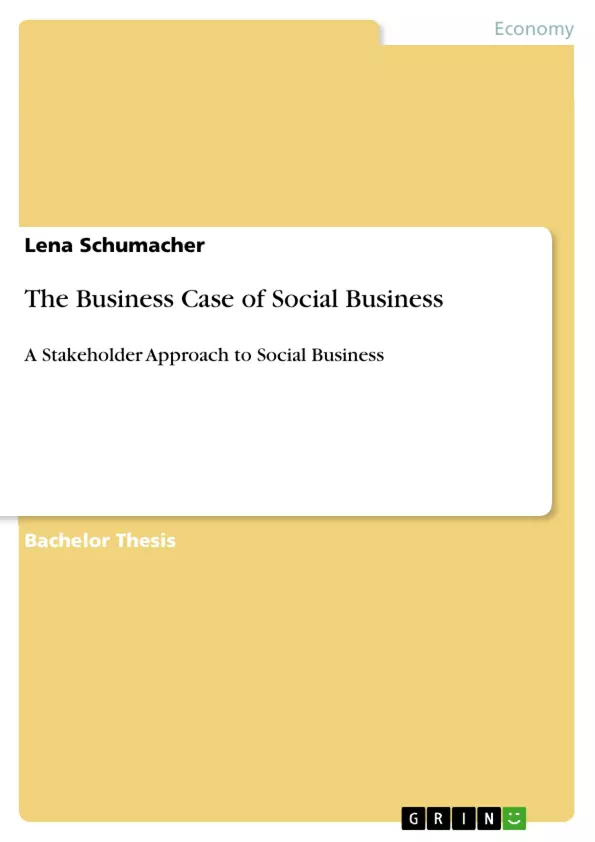During recent years, much has been written about Corporate Social Responsibility
(CSR), sustainability, sustainable and ethical supply chains, and the power of
organizations that reaches beyond their core business activities. Social Business, a rather
new form of using corporate power in order to act in a socially desirable manner, was
first established by Professor Yunus, Noble Peace Prize winner (2006). It is in contrast
to charity because it is not a donation or charitable giving but a real investment into a
business. The important difference is that with a social business the entrepreneur or the
participants in a social venture business do not intend to maximize profits but will
always reinvest profits into the business and will keep costs and prices low so a broad
range of non-affluent consumers can afford the product or service (Yunus, Bertrand, &
Lehmann-Ortega, 2009, p. 5). Yunus (2006) calls this “doing business for others instead
of for oneself” (p. 4).
Since Social Business is a very new concept, little has been written about it yet. There is
not even a generally accepted and shared definition of the term “Social Business”.
Millions of small social start-ups, whose founders intend to do something socially
beneficial and who only take out from the business the money they need for their own
upkeep, already exist. However, to differentiate between charity projects and real social
businesses is difficult. For this reason, it is impossible to collect empirical data about
these start-ups and projects. Much more in the focus of the public eye are social
businesses founded by multinational companies (MNCs) or at least renowned national
companies. This often includes a product relating to the key competence of the firm
which is adapted to the needs of less-well-off consumers and thereby solves a shared
social problem. MNCs often use the know-how and competence of non-governmental
organisations (NGOs) or similar institutions and start social joint-ventures. Since it is
much easier to collect data about this kind of social business and since their influence
and recognition in industrialized countries at the moment is much bigger than of the
numerous small start-ups, this paper is going to focus on social businesses initiated by
big companies.[...]
Inhaltsverzeichnis (Table of Contents)
- Introduction
- Problem Definition and Objectives
- Course of Investigation
- Stakeholder Theory
- Stakeholders
- Including Stakeholders in Strategic Decisions
- Inducement-Contribution Theory
- Definitions
- Applying the Inducement-Contribution Theory
- A Stakeholder Approach towards Social Business
- The Concept of Social Business
- Why Social Business?
- The Principle of Social Business
- Social Business versus Corporate Social Responsibility
- Social Business versus Social Entrepreneurship
- Stakeholders' Inducements for engaging in a Social Business and their Contributions
- Stakeholder Theory and Social Business
- Managers
- Investors
- Customers
- Shareholders
- Competitors
- Employees
- Non-Governmental Organizations
- The Concept of Social Business
- Methodology
- The Business Case of Grameen Danone Food Limited
- Partners of the Joint Venture
- The Danone Group
- The Grameen Familiy
- Grameen Danone Food Limited as the First Real Social Business
- Evolvement of the Business Idea
- Objectives of Grameen Danone Food Limited
- Financing of the Company
- Support by the Global Alliance for Improved Nutrition
- Partners of the Joint Venture
- Conclusion
- Summary
- Impact and Limitations
Zielsetzung und Themenschwerpunkte (Objectives and Key Themes)
This thesis aims to explore the business case of social business by taking a stakeholder approach. It analyzes how different stakeholders are incentivized to engage in social business ventures and how their contributions contribute to the success of these ventures. Key themes explored in the thesis include: * The concept of social business and its distinguishing features * The role of stakeholder theory in understanding social business models * The inducements and contributions of various stakeholders involved in social business * The application of these principles to the case of Grameen Danone Food Limited, a pioneering social business venture.Zusammenfassung der Kapitel (Chapter Summaries)
The introductory chapter outlines the problem definition and objectives of the thesis, exploring the business case of social business from a stakeholder perspective. It also details the course of investigation that will be followed. Chapter two examines stakeholder theory, defining key concepts and exploring the inclusion of stakeholders in strategic decision-making processes. Chapter three presents the Inducement-Contribution Theory, providing definitions and discussing its application within the context of social business. Chapter four delves into the concept of social business, outlining its key features and comparing it with other business models like Corporate Social Responsibility and Social Entrepreneurship. It then explores how various stakeholders are induced to engage in social business ventures and their respective contributions. Chapter five outlines the methodology used in the research, setting the stage for the in-depth case study of Grameen Danone Food Limited. Chapter six focuses on the business case of Grameen Danone Food Limited, exploring the partners involved in the joint venture, the company's evolution, objectives, financing, and support from the Global Alliance for Improved Nutrition.Schlüsselwörter (Keywords)
The central focus of the thesis lies in the interplay of key concepts: social business, stakeholder theory, inducement-contribution theory, and their application to the case of Grameen Danone Food Limited. These concepts, along with related themes of corporate social responsibility, social entrepreneurship, and stakeholder engagement, provide a rich foundation for understanding the business case of social business.- Quote paper
- Lena Schumacher (Author), 2010, The Business Case of Social Business, Munich, GRIN Verlag, https://www.grin.com/document/229960



